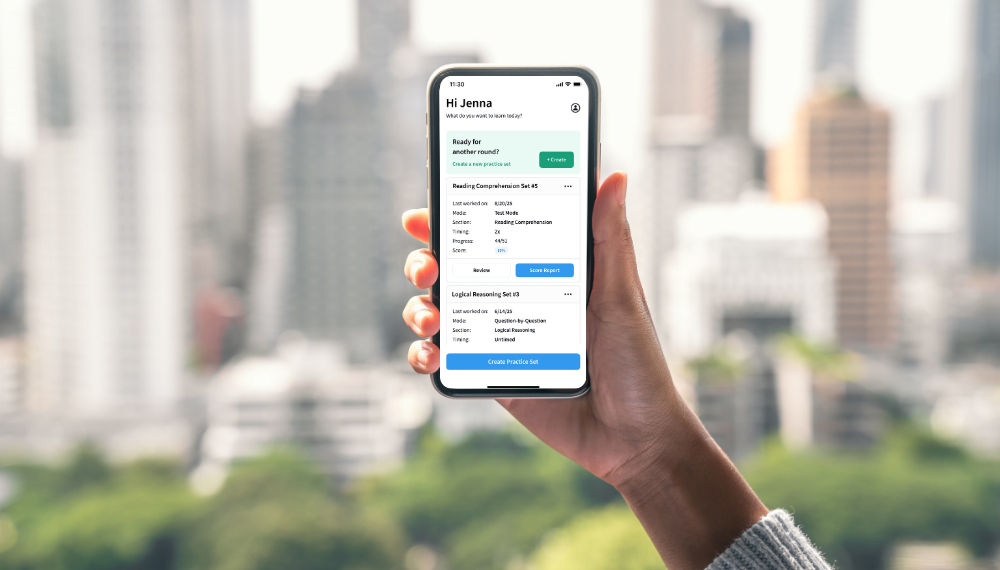“Prepping for the LSAT is like training for a marathon.” Maybe you’ve heard this before? I used to give my students that line when they asked how long to study for the LSAT. We even wrote a blog post about it.
Then, a month ago, for the first time, I actually ran a marathon.
I’m not sure I’d recommend it. It was long, physically painful, mentally exhausting, and I just wanted it to be over. Turns out, prepping for the LSAT is a lot like running a marathon. You have to pace yourself!
Me, on the other hand . . . I didn’t have the best race plan.
At the starting gun, brimming with motivation and riding the energy of the crowd, I thundered down the main road. My pace was a minute per mile faster than it should have been. With 14 miles still to go, I was french toast. Burnt out. I’d hit what runners call “the wall.”
My finish time wasn’t bad for a first marathon. But had I planned more carefully and stayed within my limits, I could have achieved a better result.
With LSAT prep, the same wisdom applies. You want to invest enough time, energy, and strategy to set yourself up for success. But you also don’t want to burn out and hit the wall. A high LSAT score can change your life. How long do you need to study for the LSAT to achieve that result? The answer varies depending on your starting point, your goals, and your study habits. Let’s break it down.
The Ideal LSAT Prep Timeline
For most students, we recommend you study for the LSAT for about three to six months. Why the range?
Generally, we have found that successful students invest a total of 200 to 300 hours of study time. How these hours break down really depends on your personal schedule and other life commitments.
Calculate How Long You Should Study for the LSAT
Sample LSAT Study Plans
12-Week Intensive Plan
Let’s say you have the better part of three months to throw everything you’ve got at the LSAT. Maybe you’re a student on summer break, or you’re taking a sabbatical from work. In this case, an accelerated 12-week plan might work for you.
Be warned: this is the P90x of LSAT study plans. You will whip yourself into the best mental shape of your life, but it’s going to take dedication and commitment. You’ll be studying 20 hours per week at a minimum, ideally pushing 30.
Find a nice quiet study room at your local library and lay out the welcome mat: this is your home now.
If you choose this plan, you need to be wary of burnout. It can be done, but not at the expense of your sleep, strength, or sanity. You can study six days a week, pedal to the metal, but give yourself that weekly rest day!
4-5 Month Balanced Plan
Many students end up giving themselves a bit more time, around the space of 4 to 5 months. Some students start off with the 12-week intensive plan, only to quickly realize they need more time. Either way, 4 to 5 months is a balanced timeline that gives students the space to learn the material while still having ample time at the end for taking additional practice tests and addressing weaknesses.
Still, 200-300 hours over 4-5 months works out to about 12-18 hours per week. That’s a part-time job!
If you’re in school, consider lightening your credit load for the semester or taking a break from extracurriculars. If you work a 9 to 5, don’t take on any additional assignments or time-consuming projects. You’ll need all the added time and energy you can find.
6 Month+ Plan
Some students find they need six months or more to study for the LSAT. Maybe you’re a full-time student with a demanding course load and a campus job. Maybe you’re both a full-time employee and full-time parent.
Whatever the case may be, you can still succeed on the LSAT. It’s just going to take more time. A more protracted study period allows you to spread those 200-300 hours over a longer timeline, ensuring you are prepared while balancing everything else that’s going on in your life.
For students on this type of plan, I like to remind them of the parable of the Tortoise and the Hare: slow and steady wins the race! Studying 200-300 hours in 6 months breaks down to about 7-11 hours per week.
Further Reading
Other Considerations
Whether you’re in the 6-month camp or the 12-week (boot)camp, Blueprint’s LSAT Live and 170+ Courses are structured with a variety of study plans in mind. Many of our courses are on an accelerated schedule, meeting two or three times per week to accommodate students on tighter timelines.
On the flipside, many Blueprint students will often finish one of our courses, then continue self-studying using our platform for an additional month or two. This allows them to review their analytics (i.e., data on their strengths and weaknesses), create additional problem sets, and take more practice LSAT tests.
Sign up to get expert tips and exclusive invites to free LSAT classes and law school admissions workshops!
While the 200-300 study hour range applies to most students, it’s not quite “one size fits all.” You might need more study time (or less) depending on your starting point and your end goal. If two students have a goal score of 165, but one has a diagnostic score of 145 and the other has a diagnostic of 155, the former student will need more study time than the latter to reach their goal.
Final Thoughts
Prepping for the LSAT is like running a marathon. I learned that the hard way. But if you plan carefully and pace yourself, your experience need not be as painful as mine was.
A month after crossing the finish line, on a whim, I entered a local 5k race. Normally, even a 5k is pretty tough, but after the marathon, it was easy breezy–the best race of my life. Taking the LSAT can be much the same, provided you pick the right study plan and follow through.
Ready to start your training? Blueprint understands that every LSAT test-taker is unique. Whether you have the discipline to study on your own with a Self-Paced Course, want to navigate the LSAT with instructors in a Live Course, or prefer one-on-one attention through tutoring, we have the study method that fits your learning style.
Get started today for free by creating a free Blueprint account to access a free practice test, analytics, study planner, video modules, and more.




